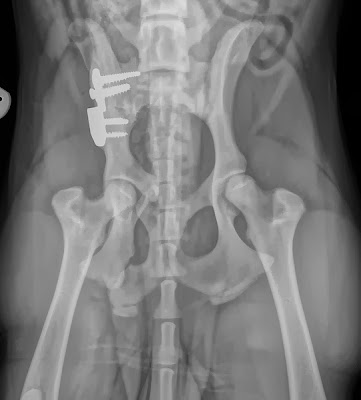When all hope seems lost for a dog experiencing canine hip dysplasia, surgery is the best option. Although they may be pricey, they are able to completely heal and relieve the dog of its symptoms that lower its quality of life. Overall, this degenerative pelvic and femoral condition is able to take a lot out of a dog, considering the fact that it can cause arthritis and . During the early and mild stages it can be quelled through the use of glucosamine supplements and other treatments, but when it is too severe, surgery is a must. Currently, there are three types of surgical procedures used to treat hip dysplasia:
Femoral Head Osteotomy
 |
| Femoral head excision |
First off, canine hip dysplasia happens when the femoral head (the ball of the hip joint) and the socket (in the pelvis) are loose. This gradually worsens over time and introduces a variety of diseases and complications like muscle atrophy and osteoarthritis. The latter is characterized by inflamed and oftentimes painful joints. Here are some facts for easy reference:
- This surgery involves the removal of the femoral head, the part of the femur that connects the leg to the socket.
- After the procedure, the body forms a fibrous attachment or scar tissue naturally forms between the femur and the pelvis.
- This restores 70% or more of the dog's hip and leg mobility, and removes the symptoms and pain caused by arthritis.
- This surgery usually has no complications and is highly recommended if the dog is downed by arthritis.
As a responsible dog owner, there are some things that you must take into account, which are:
- This procedure is only fit for small and medium sized dogs which weigh 45 pounds or less.
- The recovery period usually lasts a full year.
- Both legs have to be operated at the same time if both are afflicted by arthritis and hip dysplasia
- After a few weeks, the light activity is recommended to prevent muscle degeneration. Short and light walks as well as swimming is highly recommended.
Within six months to a year, a dog that has undergone this surgery will move about and play as if it had no dysplasia or had undergone surgery. Remember though, listen to your veterinarian for post-surgery care.
Triple Pelvic Osteotomy
 |
Triple
Pelvic Osteotomy
|
This procedure is only exclusive for young dogs, about seven to eight months old. It also has to be a time when canine hip dysplasia is discovered pretty early, before degenerative effects appear. This involves the following:
- This surgery involves the cutting of the socket or acetabulum at three points. After which, it is rotated so that the pressure exerted by the femoral head is directly on where it should be.
- Metal plates, screws and wires are then used to attach the acetabulum into the pelvis into its new position.
- Recovery takes six to 10 weeks.
Remember though, this procedure has to be done at the right time – do it earlier than seven months and the puppy's bones will not be able to support the metal points, do it late and you do not have a time frame that allows the acetabulum to have a chance to remodel itself.
Total Hip Replacement
The best way to completely cure canine hip dysplasia without any symptoms is by this surgical procedure. As its name suggests, this replaces the hip joint and socket with artificial joints, thereby eliminating hip dysplasia and the symptoms that come with it. Though the cost is pretty expensive, it is highly recommended, especially for large dogs. There are no complications and the results are nothing short of excellent.
Regardless of your treatment option, you need to be able to find a way to ease the pain caused by the canine hip dysplasia and support your pet throughout the recovery process. Before resorting to invasive medical procedures, you must give your pet glucosamine supplements that support joint and cartilage growth.






1 comments:
I gotta favorite this website it seems very helpful .
Customerhealthguide
Post a Comment